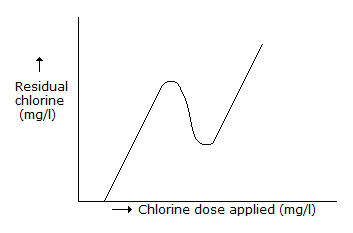Civil Engineering :: UPSC Civil Service Exam Questions
-
Consider the following oxides :
1. Al2O3
2. CaO
3. SiO2
The correct sequence in increasing order of their percentage in an ordinary portland cement is -
The modules of elasticity (E) of concrete is given by
-
A 6 hour storm has 6 cm of rainfall and the resulting runoff was 3 cm. If φ = index remains at the same value, which one of the following is the runoff due to 12 cm of rainfall in 9 hours in the catchment?
-
In the plot of residual chlorine versus chlorine dose applied shown in the above figure, the curve will not have any (0, 0) point because

-
Which of the following pairs regarding the defects in timber are correctly matched ?
1. Upsets....due to overmaturity and unventilated star age of wood.
2. Fwciness....due to crushing of fibres running transversel.
3. Star shakes....radial splits widest at the circumference and diminishing towards the centre.
4. Heart shakes....cracks widest at the centre and diminishing towards the outer circumference.
Select the correct answer using the codes given below. -
The description of solid waste collected is as follows :
Night soil - 35 t
Rubbish - 40 t
Debris - 25 t
Garbage - 40 t
The organic solids in the above composition is -
Lacustrine soils are soils
-
If a sluice gate produces a change in the depth of water from 3.0 m to 0.6 m, then the force on the gate is about
-
When the bubble of a level tube was moved by 10 divisions, the change in staff intercept was 0.05 m. If the distance between the staff and the instrument was 100 m, then the senstitiveness of the bubble tube is given by
-
Self-cleansing velocity is
|
A.
the minimum velocity of flow required to maintain a certain amount of solids in the flow
|
|
B.
the maximum velocity of flow required to maintain a certain amount of solids in the flow
|
|
C.
such flow velocity as would be sufficient to flush out any deposited solids in the sewer
|
|
D.
such flpw velocity as would be sufficient to ensure the sewage does not remain in the sewer
|


 Whatsapp
Whatsapp
 Facebook
Facebook

